

William Stopford
2026 Suzuki Jimny XL review
17 Hours Ago
Hyundai's electric Ioniq 5 SUV has been treated to another update for 2024, but it's not here yet. Should you wait?
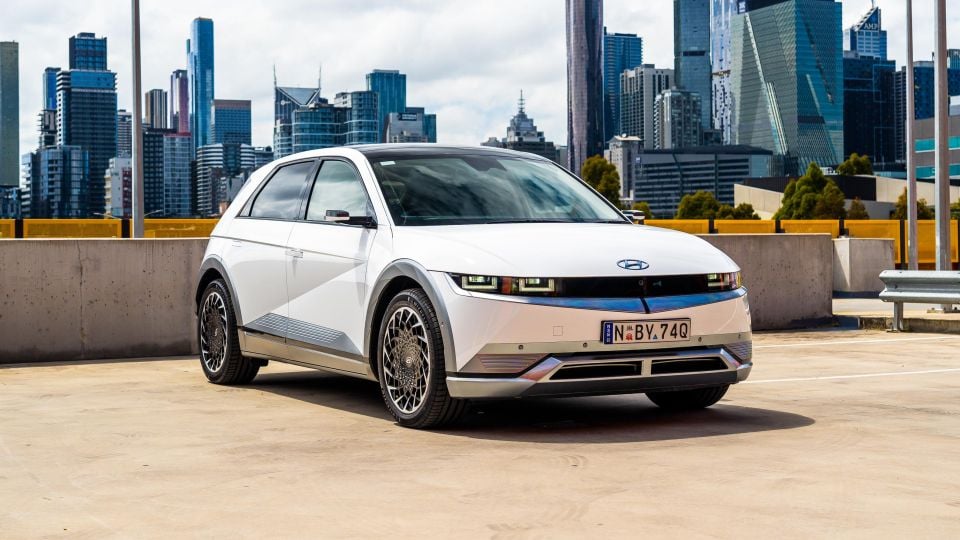


Contributor

Contributor


Contributor

Contributor
Quickly see how this car stacks up against its competition. Select any benchmark to see more details.
Where expert car reviews meet expert car buying – CarExpert gives you trusted advice, personalised service and real savings on your next new car.
Hyundai isn’t resting on its laurels when it comes to the Ioniq 5.
The retro-futuristic electric SUV only launched in 2021, but it received a slew of updates in 2022 designed to refine it further.
Along with updates to the safety technology, Hyundai gave the car more power, a bigger lithium-ion battery, retuned suspension, and the option of a new high-efficiency heat pump in range-topping models. The Epiq on test here also picked up digital side mirrors.
Hyundai has since announced yet another (more significant) update, but it’s not set to touch down in Australia until the middle of this year. Should you snap up the current model before it’s gone, or hold fire until the updated Ioniq 5 arrives?
Pricing was up in the Ioniq 5 range at the bottom end for 2024, but the Epiq on test wasn’t affected.

2024 Hyundai Ioniq 5 pricing:
All prices exclude on-road costs
To see how the Ioniq 5 compares with its rivals, use our comparison tool.
Buy your new car without the stress. It's fast, simple and completely free.

Great service from Travis and team, second time I have used this business would not hesitate to recommend them to anyone
Craig C.
Purchased a Ford Ranger in Sunshine Coast, QLD
CarExpert helped Craig save $7,224 on his Ford Ranger, now let us save you on your next new car.
Get your BEST priceThere are some familiar Hyundai parts in the Ioniq, but the design is eye-catching.

With a low scuttle and simple layout, it feels more like a lounge than a normal mid-sized SUV from behind the wheel. The white and grey colour scheme might not sound exciting on paper, but it looks upmarket in practice, and is unlike anything else available in the Hyundai Australia range.
Even the steering wheel is unbranded; the two-spoke unit instead has four dots in its centre. Hyundai has gone to great lengths to give the Ioniq brand a bit of breathing space from the rest of its lineup, and it has worked.
The sense of space is palpable, thanks in no small part to the flat floor and Palisade-aping wheelbase afforded by the E-GMP dedicated electric platform.
The driver and passenger sit in supple, electrically-adjusted seats with a huge range of motion. They slide a long way back and drop down low enough for taller drivers to get comfortable, and the way they pivot as one piece rather than making you tilt the base and backrest separately opens the door for comfortable driving positions if you’re odd-shaped like me.
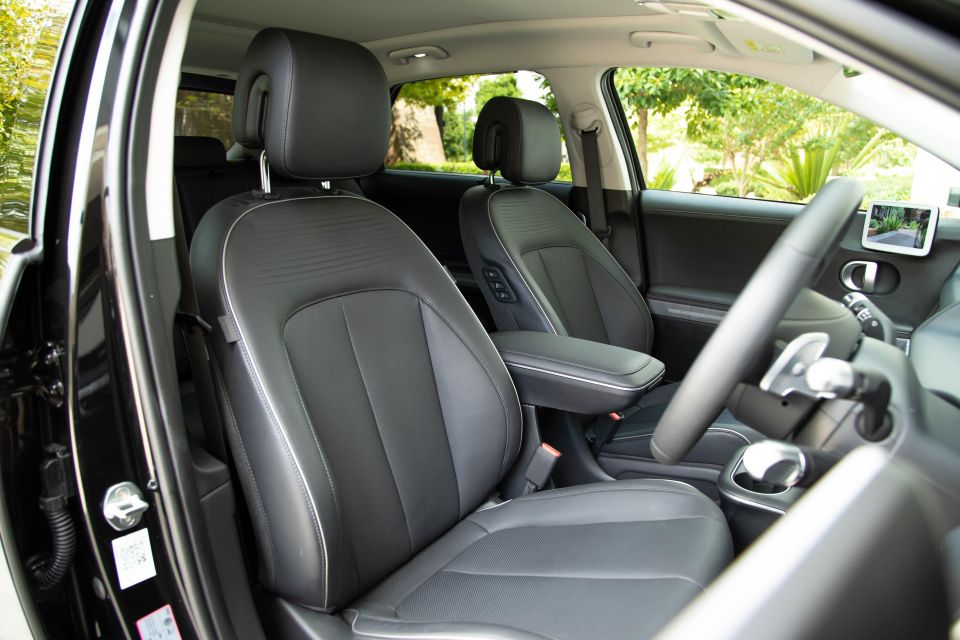
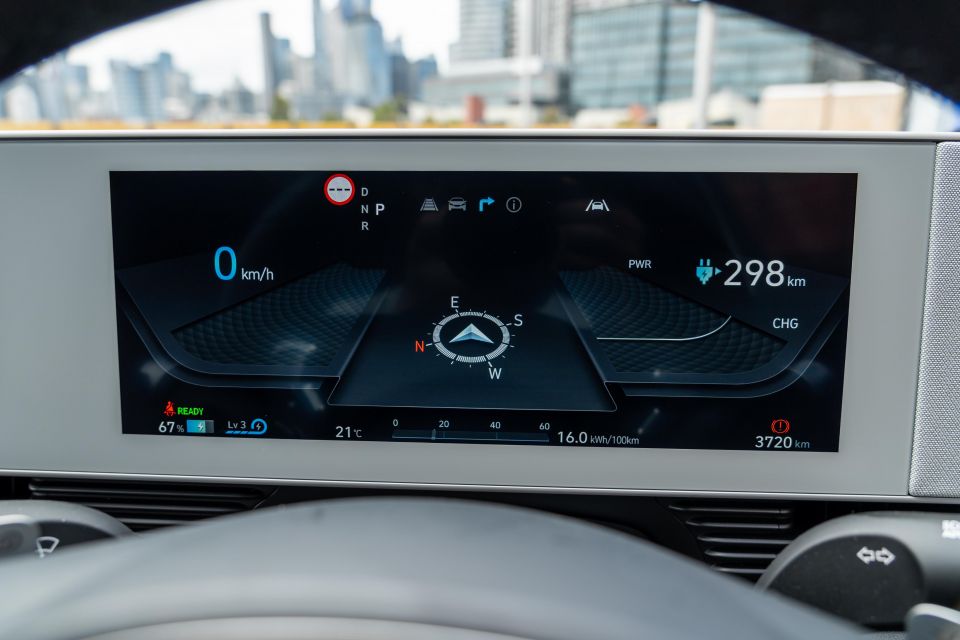
Hyundai calls them Zero Gravity seats, because they can be reclined into an airline-style bed for when you’re charging. We didn’t do any stargazing through the full-length glass roof, but we can confirm they’re ideal for napping if all the 350kW DC public charge plugs are occupied and you need to sit still for a while.
You’re not going to be short of places to store things, between the massive under-dash pocket, drawer-style glovebox, and sliding console between the front seats. It has space for a big handbag at its base, along with a padded under-arm space, a wireless phone charger, and two USB ports.
Hyundai hasn’t followed most of its rivals to offering more modern USB-C ports in its tech flagship, and the only port that supports smartphone mirroring is a long way from the driver rather than in the central space.
It’s annoying, given most modern smartphones come with a USB-C cable – although we’d wager most owners will end up just buying a cable.
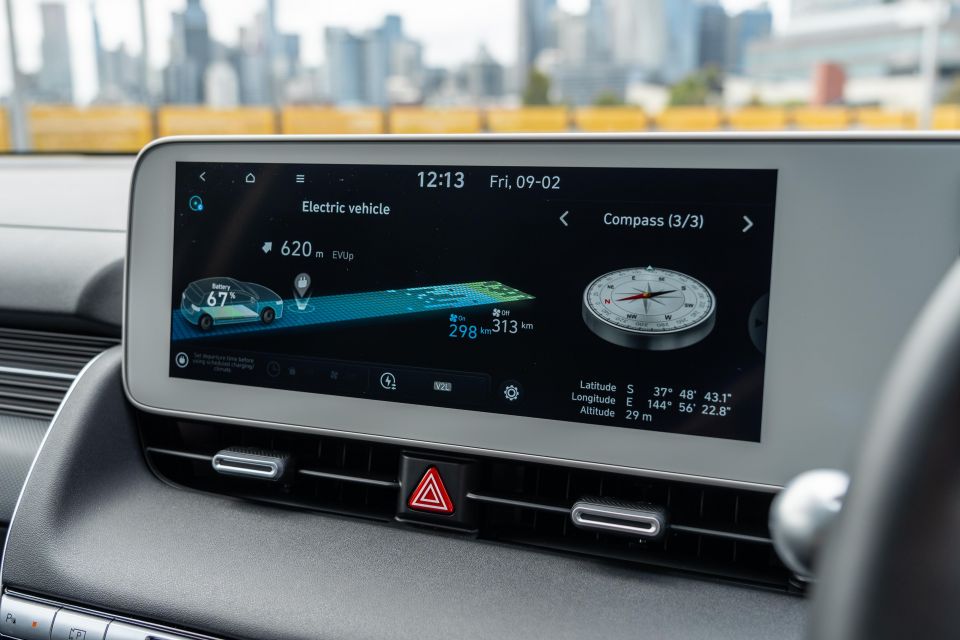
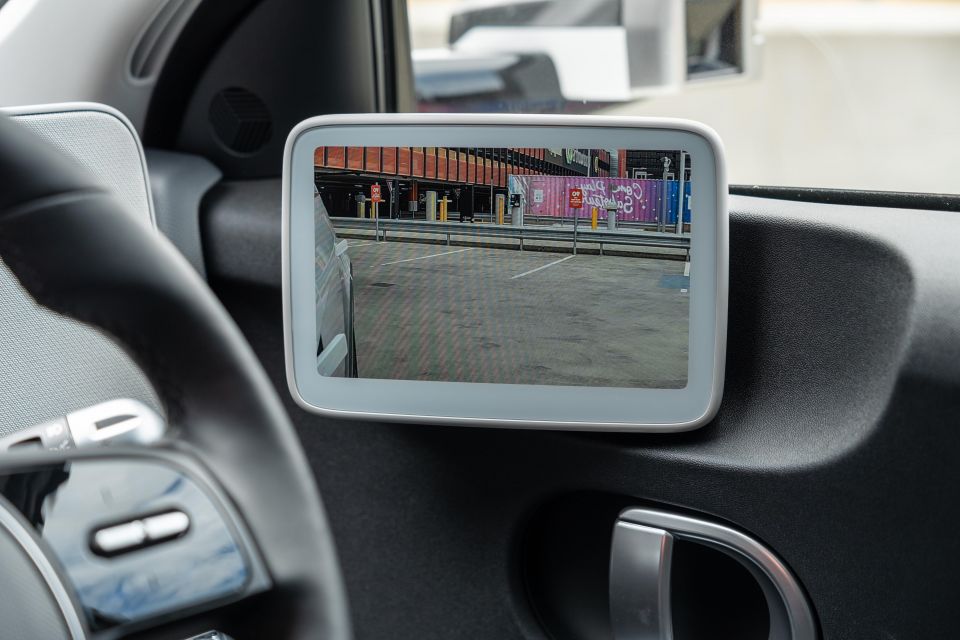
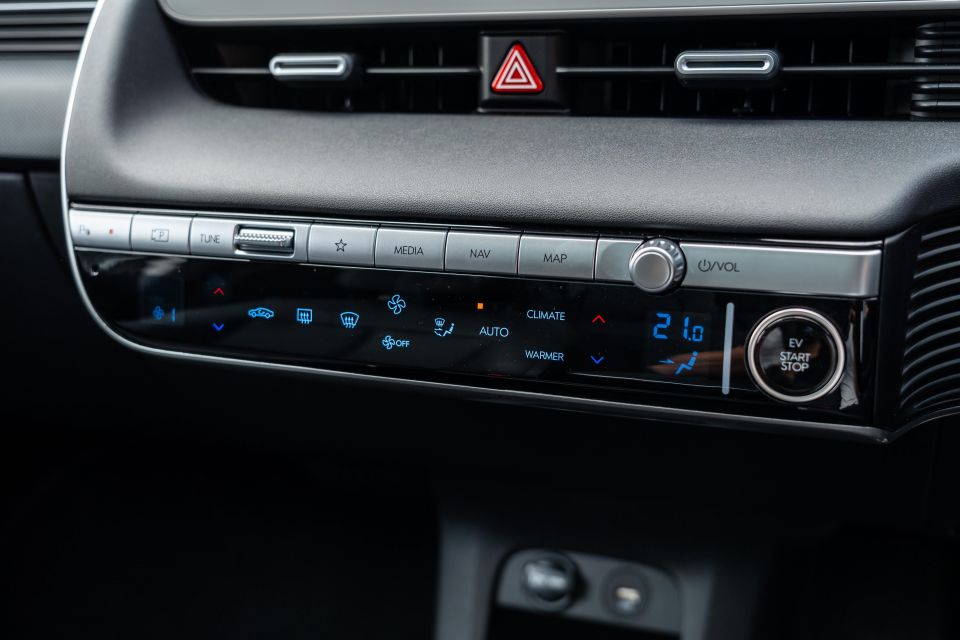

Although it’s housed in a slick-looking white surround, the infotainment system is a very minor reskin of the setup you get in essentially every other new Hyundai or Kia.
It’s mounted a long way from the driver, which makes reaching its corners hard even if you have long arms like me, but most of the menus are easy to work out on the move.
The shortcut buttons at its base are handy, but it would be good to see more electric-specific content baked into the navigation. Finding a charge station requires diving through a POI menu, for example, and it’s odd that the vehicle silhouette you see at startup isn’t an Ioniq 5. Instead it’s an i30 Hatch with a battery graphic.
These sound like small things, but they point to the fact the level of time and effort poured into differentiating the exterior hasn’t been matched by the team responsible for the infotainment.
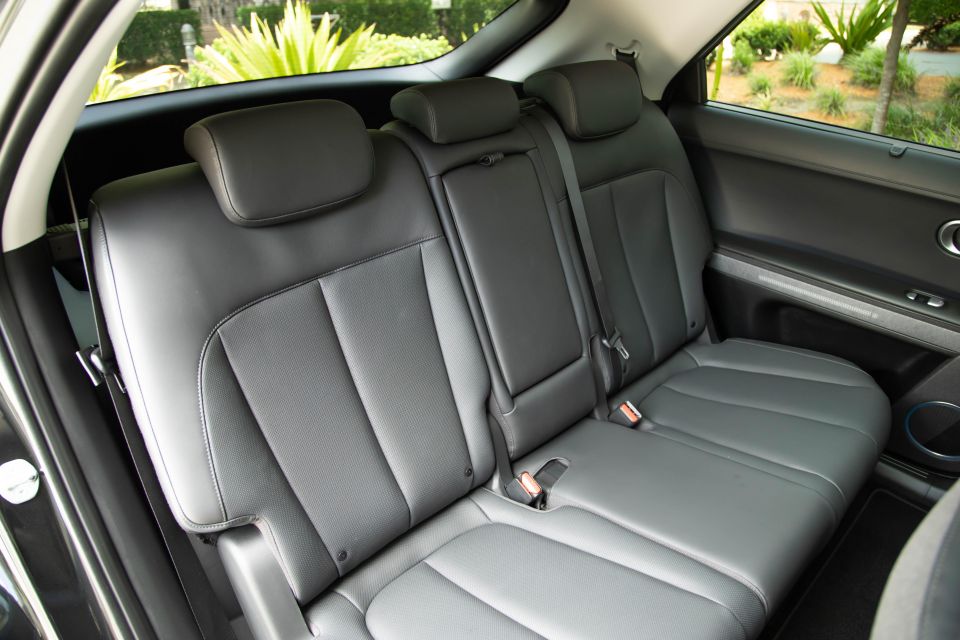
It’s functional and full-featured, but it’s also more normal than the rest of the car.
Likewise the digital instrument cluster, which can’t display live maps – and alongside the extremely polished technology in a Tesla, Polestar, or even the similarly priced BMW i4, looks a bit basic.
Beneath the touchscreen is a climate control pod with capacitive controls. It’s better than having no proper climate controls, but Hyundai still forces you to use the touchscreen to activate your seat heater.
Rear seat space is good, although toe-room is compromised by the base of the ‘zero-gravity’ seats. There’s no real hit on headroom from the panoramic roof, and legroom is impressive for leggy rear passengers. You get proper mid-size SUV space back there.




The air vents are located at face level in the B-pillars to accomodate the sliding storage space up front, and you get a fold-down central armrest, spacious door pockets, and map pockets. There are two ISOFIX and three top-tether points for child seats.
On paper, the 527L boot sounds spacious. In reality, it’s a bit limited by the angular roofline and high floor. It’ll swallow big suitcases or golf clubs comfortably, but the gap between the floor and luggage blind is slim, and most of the underfloor storage is eaten up by the subwoofer.
You get a 25L front boot and a 9.4L sliding glovebox in the all-wheel drive Ioniq 5.
The Hyundai Ioniq 5 is currently available in three different electric powertrain configurations. On test here is the flagship dual-motor all-wheel drive powertrain.
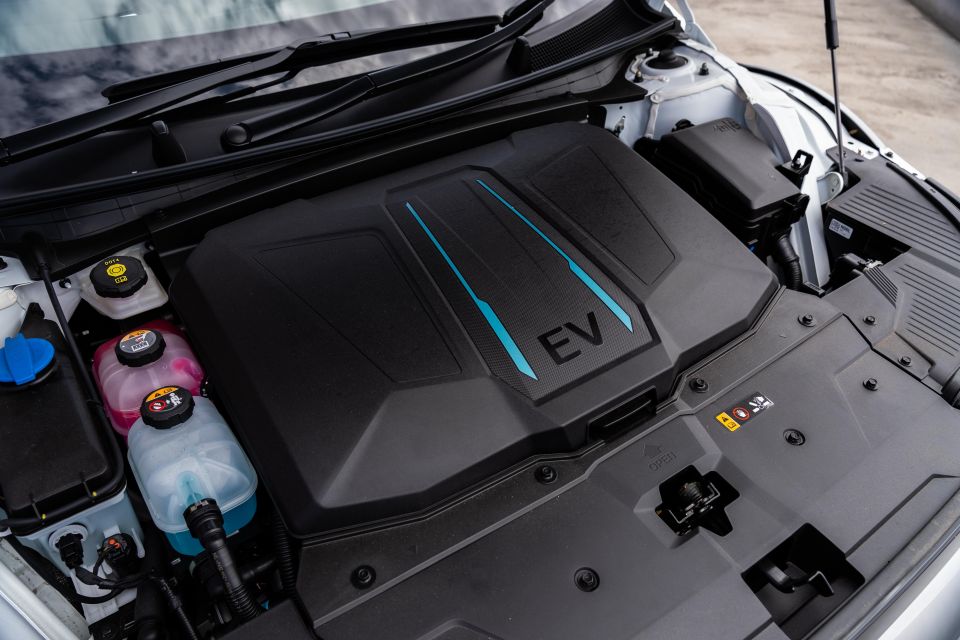
| Model | Hyundai Ioniq 5 AWD |
|---|---|
| Drivetrain | Dual-motor electric |
| Battery | 77.4kWh lithium-ion |
| Power | 239kW |
| Torque | 605Nm |
| Driven Wheels | All-wheel drive |
| Weight | 2125kg (tare) |
| Claimed range | 454km |
| Max DC charge rate | 350kW |
To see how the Ioniq 5 compares with its rivals, use our comparison tool.
The Ioniq 5 backs its lounge-like cabin with a suitably relaxed driving experience.

The ride is languid, and the way the accelerator pedal is tuned means you can precisely dole out the motors’ torque for smooth, un-fussed progress. If you want a car that’ll float you home after a hard day at work, few are more relaxing for the price.
Hyundai offers a choice of four different brake regeneration levels, including an “iPedal” mode that allows for one-pedal driving.
You can flick through the modes using the paddles behind the wheel, but you can’t set one-pedal mode as your default – it needs to be selected each time you take the Ioniq out of park. It’s an oversight that’s replicated across the Hyundai and Kia electric car ranges.
Flicked into iPedal mode, the Ioniq quickly becomes natural to drive in the city.
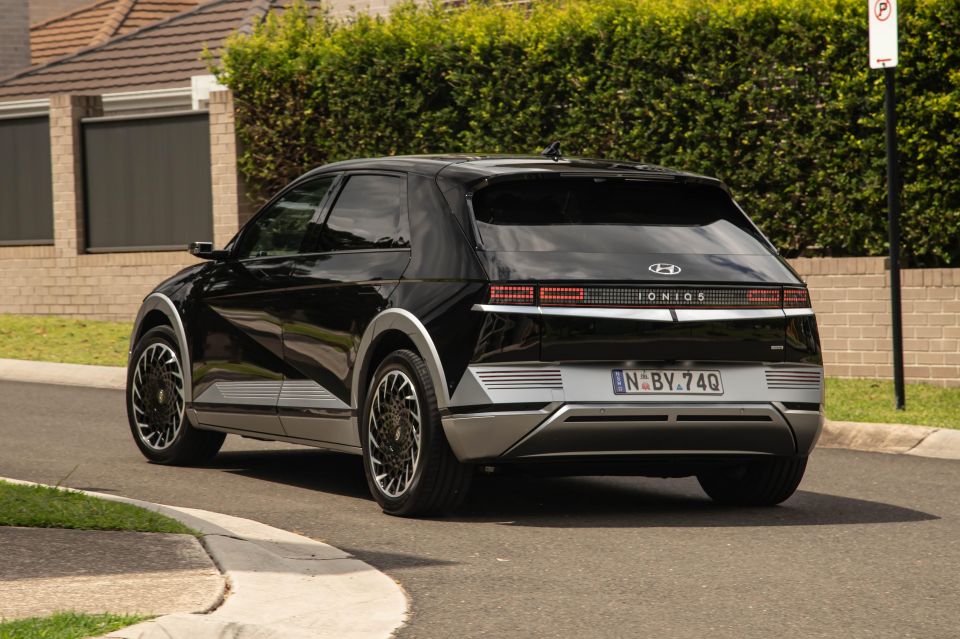
Despite the impressive outputs, it doesn’t feel neck-snappingly fast in the city unless you really put your foot down, but when you do dig deeper into the throttle’s travel this two-tonne beast is hot-hatch fast.
The steering is light and fluid, which means there’s a bit of arm-twirling required in tight spaces. It’s in keeping with the car’s plush feel, but it does combine with the long wheelbase (longer than a Palisade) to make the Ioniq 5 drive bigger than the average mid-sized SUV.
Hyundai’s suite of driver assists and cameras are generally good enough to make the Ioniq pretty easy to park, but the camera mirrors are an option we’d be steering clear of. They’re better than those on the Audi Q8 e-tron, with a broader field of view and brighter picture, but they still aren’t as easy to use as good old-fashioned mirrors.
Out on the highway, the Hyundai feels very grown up. There’s minimal wind and tyre noise, and its plush suspension means on smooth roads you just hum comfortably along. The dual-motor powertrain runs in single-motor mode at a constant speed, so you get decent economy as well.
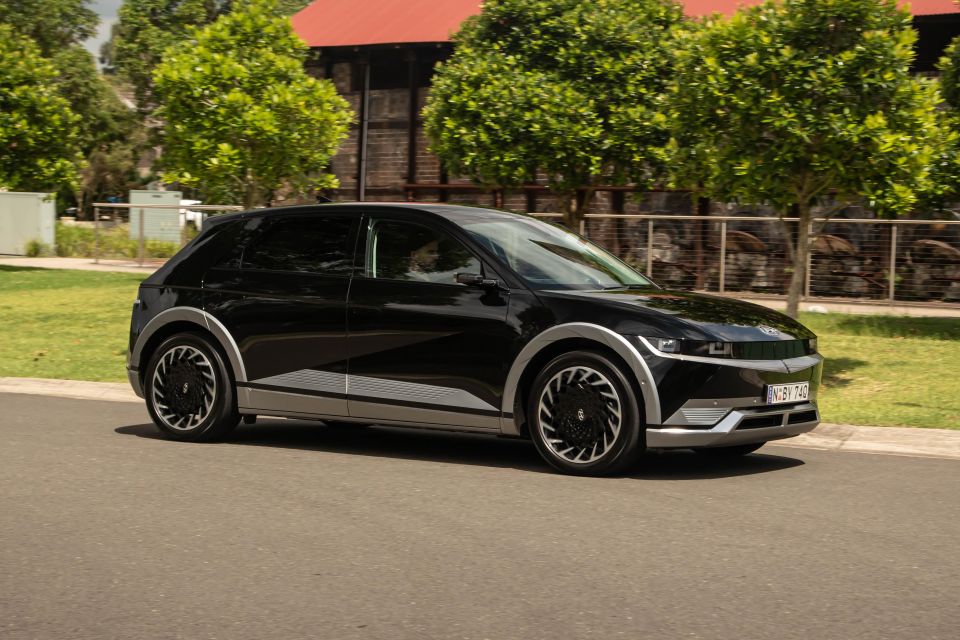
The only real chink in its armour is the way it behaves on undulating country highways, where the relaxed suspension and chunky body combine to make the Ioniq feel a bit like a boat.
It takes one, two movements to settle after big crests or dips, and successive bumps expose the slightly-too-loose body control.
Hyundai has actually updated the Ioniq 5 since its debut to feature a more sophisticated suspension tune – and the changes have made a difference – but it’s still on the looser side. Although the long-legged, languid ride is nice, we’d love the car to feel more controlled at higher speeds.
Hyundai’s active driver assist are a mixed bag. The adaptive cruise control and lane-keeping assist are both smooth and smart, but the lane-centring system – which takes a more hands-on approach to positioning the car, rather than only intervening when you stray – is too hands on for my liking.
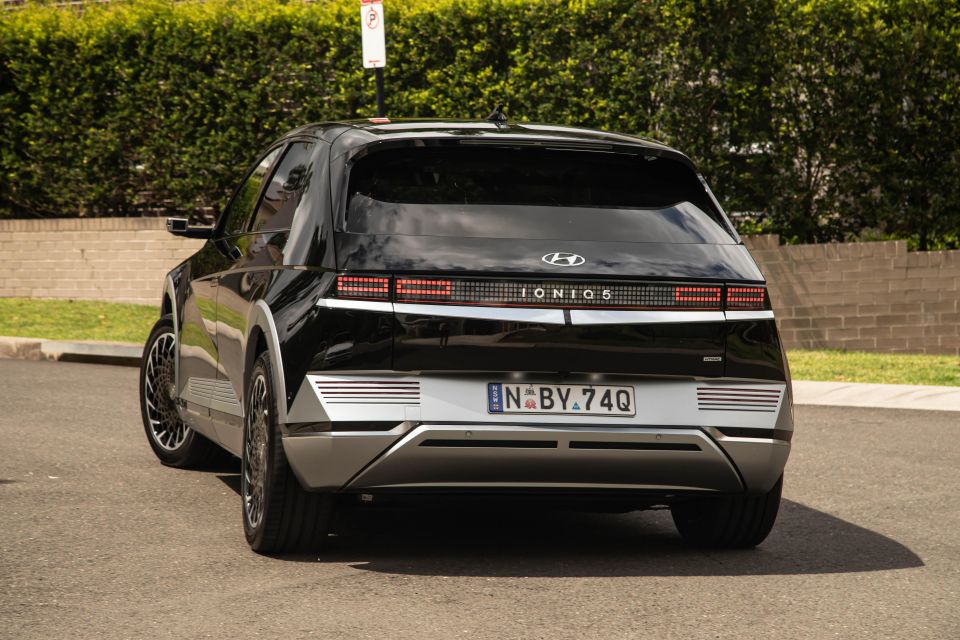
It’s also a shame the Ioniq 5 has been updated to feature Hyundai’s speed limit warning system, which beeps incessantly at you if you drift over the limit… or if it thinks you’re over the limit when you’re not.
It can’t be permanently disabled, and instead automatically activates every time you start the car.
The Hyundai Ioniq 5 is available in three trim levels locally. On test here is the flagship Epiq variant with the Digital Mirror Pack.
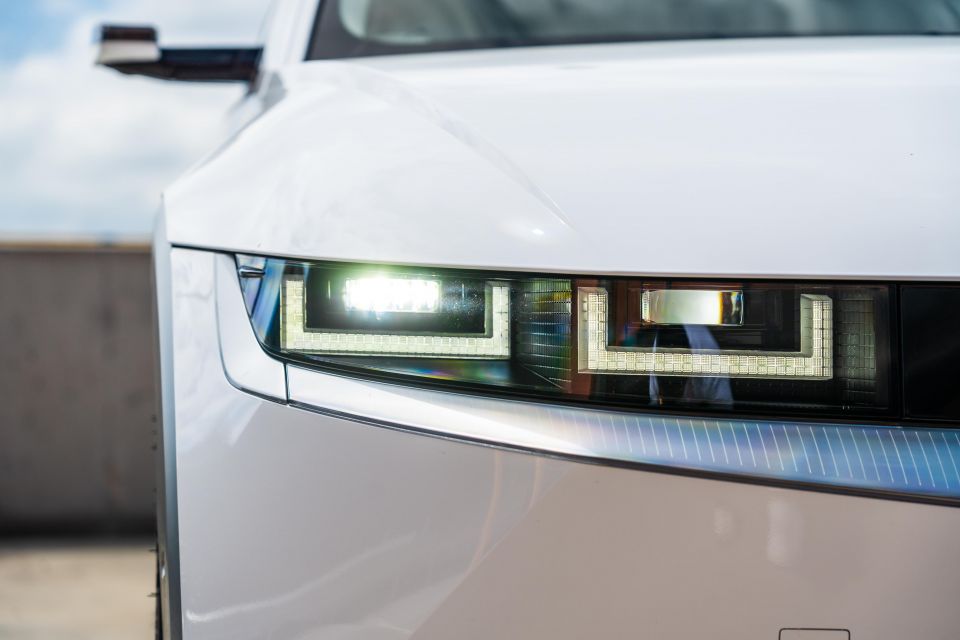

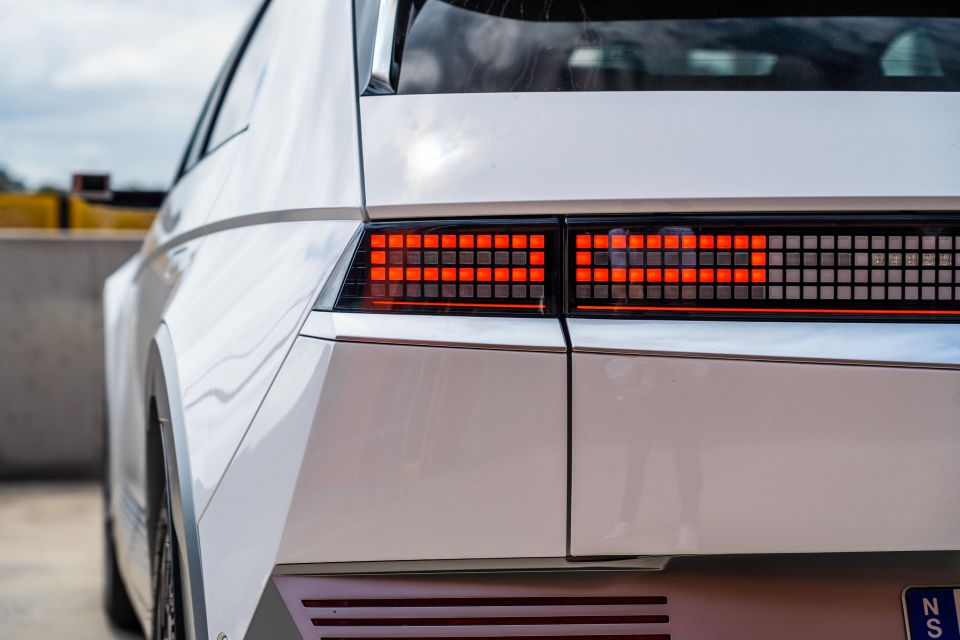

Hyundai Ioniq 5 highlights:
Dynamiq adds:
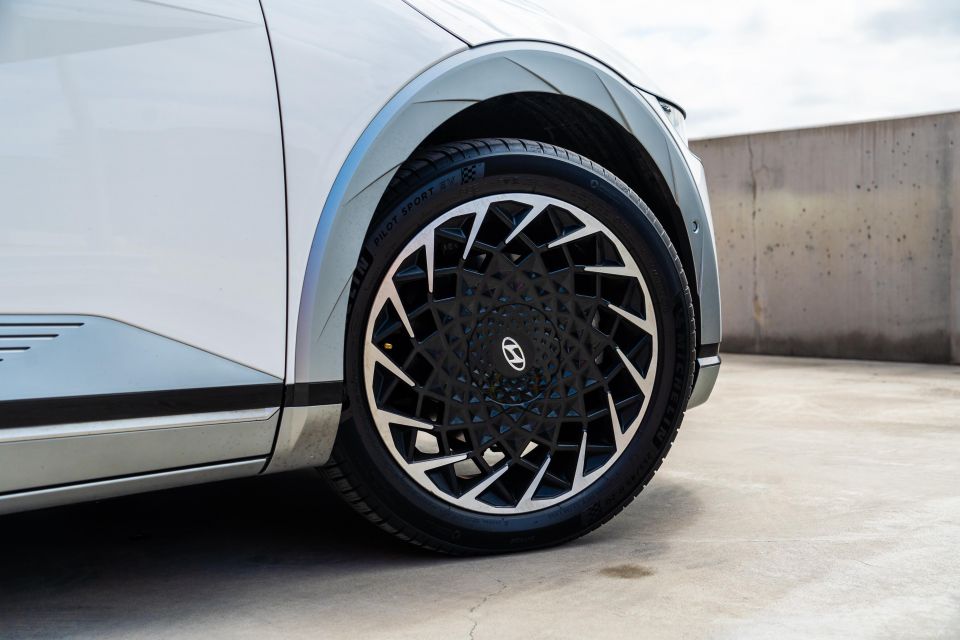

Where expert car reviews meet expert car buying – CarExpert gives you trusted advice, personalised service and real savings on your next new car.
Epiq adds:
Optional on the Epiq is the Digital Mirror Pack. It’s priced at $3000, and brings digital side mirrors and a digital centre mirror.
The Hyundai Ioniq 5 has a five-star ANCAP safety rating, which is based on testing conducted in October 2021.
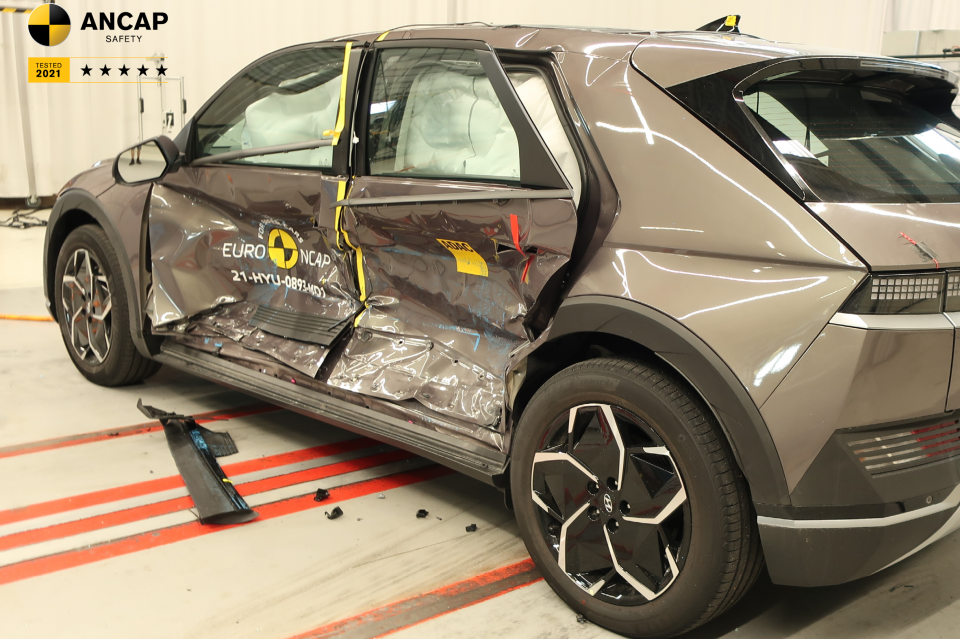
It earned its five-star rating on back of a 88 per cent score for adult occupant protection, 87 per cent for child occupant protection, 63 per cent for vulnerable road user protection, and 89 per cent for safety assist.
Standard safety equipment across the Ioniq 5 range includes:
The frontal autonomous emergency braking (AEB) feature, which Hyundai calls Forward Collision-Avoidance Assist, includes the following functionality:
The Ioniq 5 is backed by a five-year, unlimited-kilometre vehicle warranty plus an eight-year, 160,000km high-voltage battery warranty.

Servicing is required every 24 months or 30,000 kilometres, whichever comes first.
The first three services (covering six years) are capped at $570, $1090 and $570, respectively.
Buy your new car without the stress. It's fast, simple and completely free.

Great service from Travis and team, second time I have used this business would not hesitate to recommend them to anyone
Craig C.
Purchased a Ford Ranger in Sunshine Coast, QLD
CarExpert helped Craig save $7,224 on his Ford Ranger, now let us save you on your next new car.
Get your BEST priceThe Ioniq 5 is every bit as head-turning now as when it launched, and still drives with real polish.
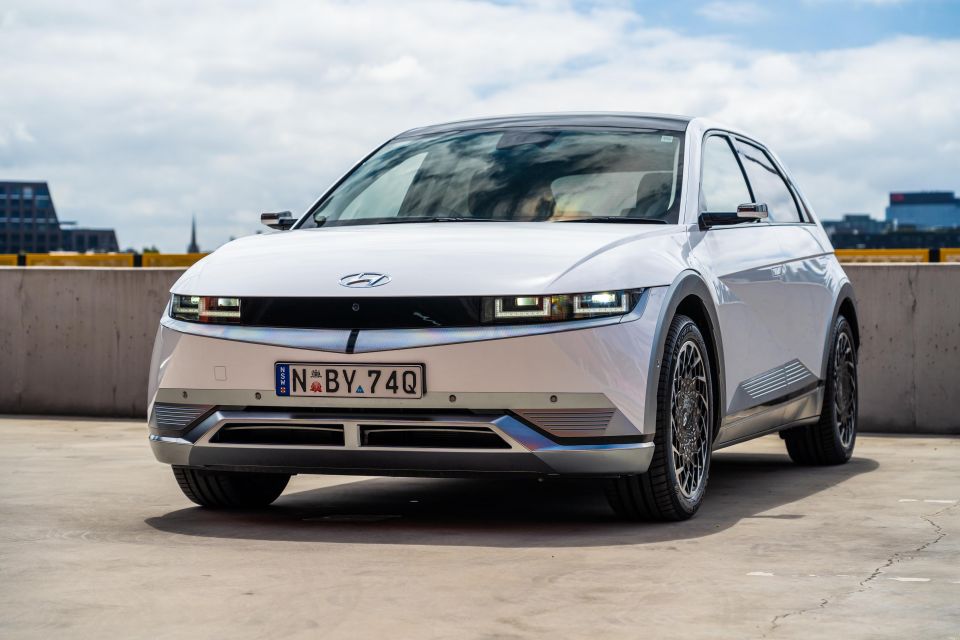
The slightly awkward boot isn’t perfect, but the cabin is otherwise very family friendly, and the relaxed suspension setup combines with smooth, silent electric power to make for a lovely commuter.
There are a few options to avoid, though. Don’t bother with the digital side mirrors, they’re not the futuristic game-changer you might expect.
Unless you’re spending a lot of time at DC public fast chargers, the extra equipment in the Epiq doesn’t really strike me as all that necessary when the cheaper Techniq sitting below it in the range is so well equipped.
Although there’s nothing wrong with the Ioniq 5 on test here, the bigger battery, smarter cabin layout, and new infotainment technology in the updated model shape as worthwhile inclusions.

Click the images for the full gallery
MORE: Buy a Hyundai Ioniq 5 MORE: Everything Hyundai Ioniq 5
Where expert car reviews meet expert car buying – CarExpert gives you trusted advice, personalised service and real savings on your next new car.
Scott Collie is an automotive journalist based in Melbourne, Australia. Scott studied journalism at RMIT University and, after a lifelong obsession with everything automotive, started covering the car industry shortly afterwards. He has a passion for travel, and is an avid Melbourne Demons supporter.


William Stopford
17 Hours Ago
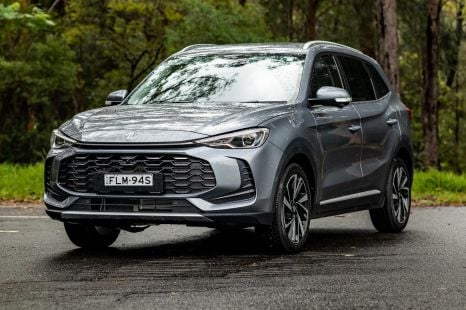

Matt Campbell
2 Days Ago


James Wong
3 Days Ago


Neil Briscoe
7 Days Ago


William Stopford
8 Days Ago
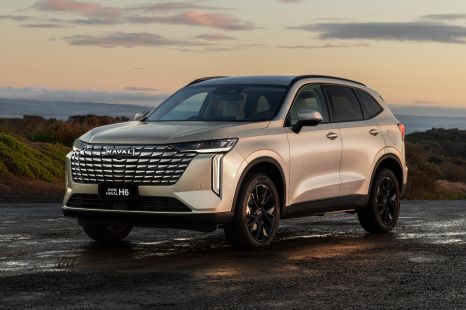

William Stopford
12 Days Ago